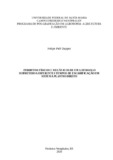| dc.creator | Dapper, Felipe Puff | |
| dc.date.accessioned | 2021-06-09T17:33:15Z | |
| dc.date.available | 2021-06-09T17:33:15Z | |
| dc.date.issued | 2020-02-20 | |
| dc.identifier.uri | http://repositorio.ufsm.br/handle/1/21093 | |
| dc.description.abstract | The soil quality physical has great importance in the development of roots of the plants, therefore
areas under no-tillage can present compaction problems result loss to crops grown in these areas.
Machine traffic is the main causative agent of soil compaction, considering that during the cycle
of a culture the same area needs to be trafficked several times in order to be able to carry out
cultural treatments. Thus the pressures exerted by the weight of the machines cause deformations
in the soil structure, expelling air from the pores causing densification the main factors that is
related to the deformation of the structure is the water content in soil matrix, the higher the
moisture content of the soil the greater its susceptibility to compaction. Compacted soils offer
resistance to root development which can result in a small volume of explored soil impairing
nutrient absorption. The objective of this work was to correlate the physical attributes of the soil,
to estimate of loud bearing capacity and to estimate last limiting water range (IHO) in different
managements conducted under no-tillage. The hypothesis tested in this work was that the time
of direct planting without mechanical intervention favors the structuring of the soil ensuring that
the soil is more resistant to the agents the cause compaction. Five areas were evaluated namely:
No-till for twenty years (SPD 20) no- for ten years (SPD 10), no-till for three years (SPD 3),
chisel cultivation (Esc) and native forest (Mata). Soil samples were collected in three layers (0-
5; 10-15; 25-30 cm), the physical attributes were measured in the laboratory, so the models of
load bearing capacity in the last limiting water range. The physical attributes of the soil change
with the increase in the time of no-tillage execution in ensuring that the soil is able to support
aggregates load. For values of 3 and 3,5 MPa, the SPD 20 had and IHO greater than zero, showing
that the SPD 20 has good conditions for root development. | eng |
| dc.language | por | por |
| dc.publisher | Universidade Federal de Santa Maria | por |
| dc.rights | Attribution-NonCommercial-NoDerivatives 4.0 International | * |
| dc.rights.uri | http://creativecommons.org/licenses/by-nc-nd/4.0/ | * |
| dc.subject | Plantio direto | por |
| dc.subject | Qualidade física | por |
| dc.subject | Compactação | por |
| dc.subject | No-tillage | eng |
| dc.subject | Physical quality | eng |
| dc.subject | Compaction | eng |
| dc.title | Atributos físicos e mecânicos de um latossolo conduzido sob diferentes sistemas de manejo | por |
| dc.title.alternative | Physical and mechanical attributes of a oxisol driven under different management systems | eng |
| dc.type | Dissertação | por |
| dc.description.resumo | A qualidade física do solo é de grande importância para o desenvolvimento das raízes das
plantas, sendo assim áreas conduzidas sob plantio direto podem apresentar problemas de
compactação acarretando em prejuízos aos cultivos realizados nestas áreas. O tráfego de
máquinas é o principal agente causador da compactação, considerando que durante o ciclo de
uma cultura a mesma área precisa ser trafegada várias vezes para que seja possível realizar os
tratos culturais. Dessa forma a pressões exercida pelo peso das máquinas causam deformações
na estrutura do solo, expulsando o ar dos poros ocasionando a compactação, sendo que o
principal fator que está relacionado a deformação da estrutura, é o conteúdo de água existente
na matriz do solo, dessa forma quanto maior for o conteúdo de umidade do solo maior será a
sua suscetibilidade a compactação. Solos compactados dificultam o desenvolvimento das raízes
o que pode resultar em um pequeno volume de solo explorado prejudicando a absorção de
nutrientes. O objetivo deste trabalho foi correlacionar os atributos físicos do solo, estimar
modelos de capacidade de suporte de carga e estimar o intervalo hídrico ótimo (IHO) em
diferentes áreas conduzidas sob plantio direto. A hipótese testada neste trabalho foi que o tempo
execução do plantio direto sem intervenção mecânica favorece a estruturação do solo
garantindo que o solo seja mais resistente aos agentes causadores da compactação. Foram
avaliados cinco áreas sendo estas: plantio direto contínuo durante vinte anos (SPD 20), plantio
direto contínuo durante dez anos (SPD10), plantio direto contínuo durante três anos (SPD 3),
cultivo escarificado (Esc) e mata nativa (Mata). As amostras de solo foram coletadas em três
camadas (0-0,5; 0,10-0,15; 0,25-0,30 m), os atributos físicos foram mensurados em laboratório,
assim os modelos de capacidade de suporte de carga e intervalo hídrico ótimo foram estimados.
Os atributos físicos do solo se alteram com o aumento do tempo de execução de plantio direto
garantindo que o solo seja capaz de suportar uma maior carga. Para os valores de 3 e 3,5 MPa
o SPD 20 apresentou IHO maior que zero, mostrando que o SPD 20 apresenta boas condições
ao desenvolvimento de raízes. | por |
| dc.contributor.advisor1 | Silva, Vanderlei Rodrigues da | |
| dc.contributor.advisor1Lattes | http://lattes.cnpq.br/7941766438504530 | por |
| dc.contributor.referee1 | Kaiser, Douglas Rodrigo | |
| dc.contributor.referee1Lattes | XXXXXXXXXXXXXXX | por |
| dc.contributor.referee2 | Silva, Rodrigo Ferreira da | |
| dc.contributor.referee2Lattes | XXXXXXXXXXXXXXXXXX | por |
| dc.creator.Lattes | XXXXXXXXXXXXXXXX | por |
| dc.publisher.country | Brasil | por |
| dc.publisher.department | Agronomia | por |
| dc.publisher.initials | UFSM | por |
| dc.publisher.program | Programa de Pós-Graduação em Agronomia - Agricultura e Ambiente | por |
| dc.subject.cnpq | CNPQ::CIENCIAS AGRARIAS::AGRONOMIA | por |
| dc.publisher.unidade | UFSM Frederico Westphalen | por |



